The Dry Eye Syndrome Treatment Market is estimated to be valued at USD 5.8 billion in 2025 and is projected to reach USD 10.8 billion by 2035, registering a compound annual growth rate (CAGR) of 6.4% over the forecast period.
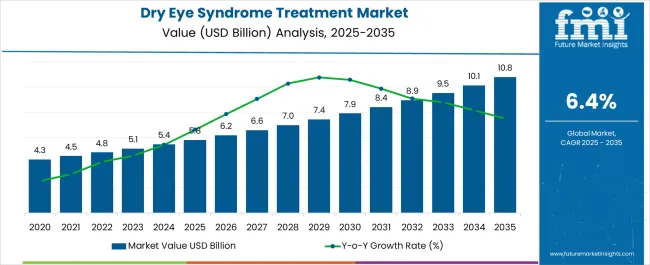
| Metric | Value |
|---|---|
| Dry Eye Syndrome Treatment Market Estimated Value in (2025 E) | USD 5.8 billion |
| Dry Eye Syndrome Treatment Market Forecast Value in (2035 F) | USD 10.8 billion |
| Forecast CAGR (2025 to 2035) | 6.4% |
The dry eye syndrome treatment market is experiencing notable expansion. Rising prevalence of dry eye conditions due to aging populations, increased screen time, and environmental stressors has strengthened demand.
Current dynamics are defined by advancements in formulations, growing patient awareness, and regulatory support for innovative therapies. Prescription dominance and strong product pipelines are driving adoption, while cost pressures and generic competition remain influencing factors.
The future outlook is marked by steady demand growth across both developed and emerging markets, with technological progress in ophthalmic solutions and improved treatment compliance contributing to sustained revenue generation Growth rationale is reinforced by the increasing integration of dry eye treatments into routine eye care, expanding access through multiple distribution channels, and the alignment of pharmaceutical development strategies with unmet clinical needs, ensuring long-term market progression.
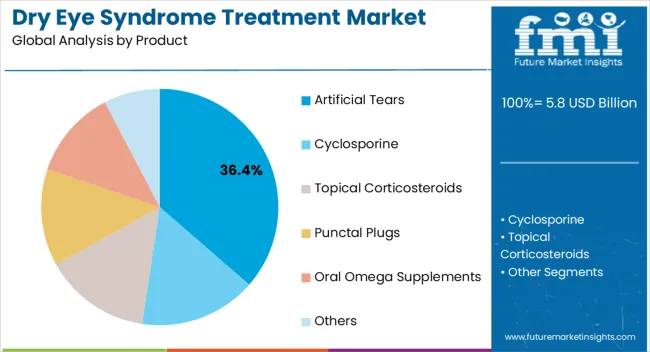
The artificial tears segment, accounting for 36.4% of the product category, is leading the market due to its widespread use as a first-line treatment for dry eye symptoms. The segment benefits from broad accessibility, affordability, and ease of administration, making it the most preferred choice for both patients and healthcare providers.
Product development has focused on enhanced formulations with improved viscosity, longer-lasting relief, and preservative-free options to cater to sensitive users. Growing adoption has been supported by rising consumer awareness campaigns and the availability of both over-the-counter and prescription variants.
Distribution through retail and online channels has further strengthened accessibility The segment is expected to sustain its position as innovation in tear substitutes and expansion of premium ranges continues to drive market demand.
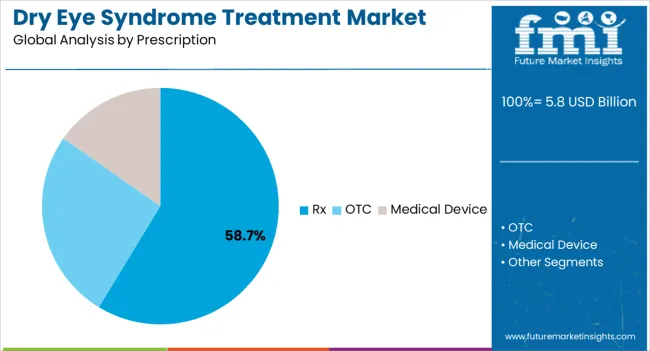
The Rx segment, representing 58.7% of the prescription category, has maintained its dominance due to strong physician recommendation and the higher efficacy associated with prescription-based formulations. Market leadership has been reinforced by robust pipelines of advanced therapies targeting underlying causes rather than symptomatic relief alone.
Growing reliance on Rx drugs has been driven by increasing diagnosis rates, improved patient adherence, and clinical trial evidence demonstrating superior outcomes. Regulatory approvals for novel ophthalmic drugs have contributed to confidence among prescribers and patients alike.
Long-term growth is expected as biologics and targeted therapies continue to penetrate the market, reinforcing the Rx segment’s central role in shaping the competitive landscape of dry eye syndrome treatment.
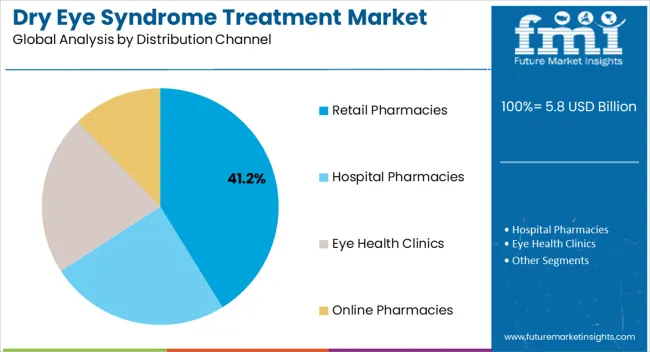
The retail pharmacies segment, holding 41.2% of the distribution channel category, has emerged as the leading channel due to its accessibility and role as a primary point of sale for both prescription and over-the-counter dry eye products. Market positioning has been supported by strong supply chain integration, convenient availability for patients, and the ability to offer a wide product assortment.
Retail pharmacies have leveraged trust among consumers and established relationships with prescribers to sustain consistent demand. Expansion of pharmacy chains in urban and semi-urban areas has improved penetration in key markets.
Future growth is expected to be supported by the integration of digital platforms and e-pharmacy services, further enhancing access and ensuring the retail channel remains central to product distribution.
Various factors drive the global dry eye syndrome treatment market. A few of these factors are as follows:
Increasing Prevalence: The increasing aging population, screen time, pollution, and other environmental factors are raising the demand for dry eye syndrome treatment. Numerous people suffering from dry eye are widely adopting dry eye syndrome treatment in healthcare facilities by professionals.
Advanced Technologies: Increasing dry eye syndrome disease is raising the demand for effective treatment options with diagnostic tools. Healthcare manufacturers offer a variety of treatments that satisfy patients' requirements, fueling the market growth.
Patient Awareness: Growing patient awareness is boosting the demand for dry eye therapies to enhance processes and outcomes. Manufacturers are initiating various awareness campaigns to provide genuine information related to dry eye syndrome treatment.
Lifestyle Changes: Changing traditional lifestyles to modern lifestyles, such as rising pollution, air conditioning, and other factors, are accelerating the demand for dry eye syndrome treatment.
Research and Development: Biotechnology and pharmaceutical companies are focused on developing effective treatments through their innovations by investing in research and development.
Regulatory Approvals: Regulatory bodies are passing approval of certain drugs and treatments suitable for patients' recovery, increasing the adoption of dry eye syndrome treatment. These authorities are clearing the approval of new therapies and expanding the market size.
Emerging Markets: The growing economies, vast healthcare infrastructure, and professionals are bringing new opportunities to the global market.
Telehealth and Telemedicine: The rapidly popularizing telehealth and telemedicine services are easier solutions to improve patient outcomes. This trend is widely accepted by doctors, surgeons, and healthcare providers to enhance treatment with consultations.
The global market faced various challenges that declined growth. A few of these challenging factors are as follows:
Untreated Cases: Numerous patients diseased with dry eye syndrome remain untreated due to a lack of knowledge and awareness. These factors are restraining the demand for dry eye syndrome treatment.
Market Saturation: The global market is saturated by prescription products, and price competition is another restraining factor.
Regulation Hurdles: Gaining regulation approval is a complex and expensive procedure. Various companies face challenges due to a lack of budget to meet requirements from regulatory authorities and a decline in market growth.
Limited Efficiency: There are various treatments available for dry eye syndrome, but not all patients respond the same, which may decline the market growth. Numerous patients' treatment goes well in a limited period, which may restrain the adoption of dry eye syndrome treatment.
Competition: Various individuals are following home remedies to improve dry eye syndrome by the traditional self-care treatment that limits the demand for dry eye syndrome treatment.
The growing innovations and new product launches are rapidly driving the global market to improve patients' dry eye disease therapy.
The growing advanced technologies and smart technologies are reducing the workload of treatment and improving patient care with quick solutions.
Rising therapeutics facilities are enhancing patients' treatment, reducing numerous symptoms related to dry eye syndrome, and improving quality of life.
Manufacturers are boosting dry eye syndrome treatment sales through effective dry eye syndrome therapies across regions. Healthcare professionals are offering dry eye treatment drops to relieve patients' symptoms and expand the global market size.
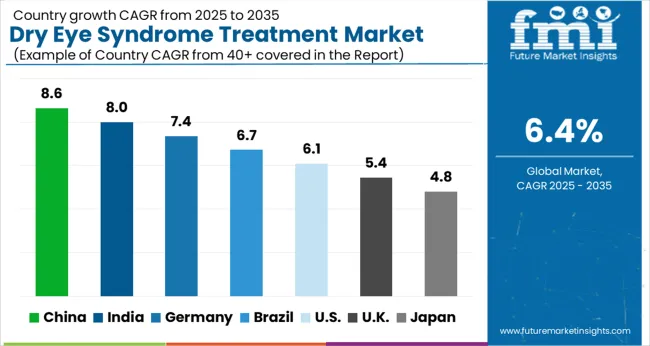
| Countries | CAGR (2025 to 2035) |
|---|---|
| China | 8.6% |
| India | 8.0% |
| Germany | 7.4% |
| Brazil | 6.7% |
| United States | 6.1% |
| United Kingdom | 5.4% |
| Japan | 4.8% |
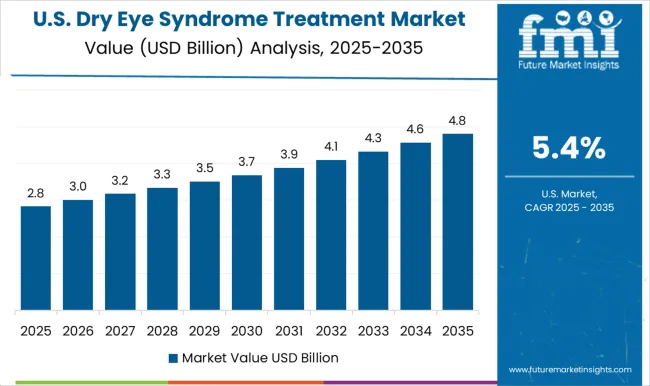
The United States is estimated to secure a CAGR of 6.1% during the forecast period. The increasing prevalence of dry eye syndrome, the generic population, and the rising gaming and virtual activities are accelerating the demand for dry eye syndrome treatment.
The United States has vast healthcare systems that prefer patients' desire for certain treatments, significantly increasing the market size.
Increasing research and development, biotechnology, and pharmaceutical industries are innovating advanced therapies to drive the United States dry eye syndrome treatment market. The USA Food & Drug Administration approves medical prescription and eye treatment therapies that enhance the market revenue. On the other hand, healthcare manufacturers are offering affordable treatment to enhance patients' outcomes with budget-friendly treatments.
The United Kingdom market is estimated to grow at a CAGR of 5.4% over the forecast period. The increasing screen time among youngsters, rising dry eye syndrome patients, and prevalence conditions are driving the United Kingdom's dry eye syndrome treatment market. Rising eye care professionals to cure patients increases the demand for dry eye syndrome treatment.
Growing patient awareness, increasing advanced technologies, and over-the-counter products are surging the adoption of dry eye syndrome treatment. The increasing cost of treatments enhances health insurance to bear expenses related to treatment, contributing to market growth.
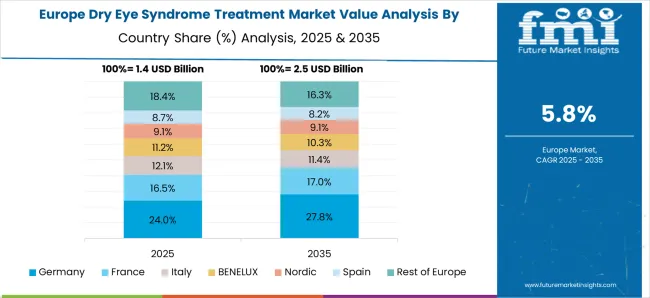
Germany is anticipated to capture a CAGR of 7.4% through 2035. The changing lifestyle, increasing disposable income, and rising patient eye-related problems are fueling the German dry eye syndrome treatment market. The rapidly growing medical technology and pharmaceutical sector has a key role in the market through deep research and innovations.
Patients prefer dry eye treatment to improve their conditions and treat disorders. Healthcare manufacturers are offering cost-effective solutions to seek patients with dry eye syndrome with advanced care. Key companies are collaborating with research institutions to develop new therapies and medication to improve patient outcomes, which are fueling the German market.
The market in China is likely to secure a CAGR of 8.6% through 2035. Rising concerns about eye problems, increasing air pollution, and changing lifestyles are contributing to the expansion of China's dry eye syndrome treatment market. The rapidly surging healthcare systems, high-quality treatments, and experts are increasing the adoption of dry eye syndrome treatment.
Key companies are playing a vital role in offering healthcare services with their specialized medical and affordable treatments for their patients. China's government seeks to invest a vast amount in healthcare infrastructure to offer improved and cost-effective treatment to patients that satisfy their needs.
The market in India is estimated to capture a CAGR of 8.0% during the forecast period. The increasing demand for quality of life to improve dry eye syndrome conditions is raising the adoption of advanced therapies among patients. The rising vast population and elderly patients prefer dry eye disease therapy, which is advancing India's dry eye syndrome treatment market.
Changing work cultures and living styles are increasing the prevalence of dry eye syndrome among a wide age group, and individuals are expanding the market size. Government-sponsored programs to increase healthcare awareness and insurance to improve their health condition with suitable treatment. India is rich in Ayurvedic medicine and modern therapies that enhance the quality of patient
| Top Product | Artificial Tears |
|---|---|
| Market Share in 2025 | 61.1% |
Based on product type, the artificial tears segment leads the global market by capturing a share of 61.1% in 2025. Healthcare experts and eye care hospitals are widely increasing the adoption of artificial tears to treat dry eye syndrome.
The demand for artificial tears is popularly growing among patients for the treatment of moderate and mild dry eye problems. These tears are affordable and enhance medical treatment that attracts patients' desires.
Healthcare manufacturers produce a wide range of artificial tears, such as gel-based ones for specific dry eye type patients, which significantly boosts the market growth. Changing lifestyles and rising environmental pollution contribute to dry eye syndrome, increasing the adoption of artificial tears.
| Top Distribution Channel | Retail Pharmacy |
|---|---|
| Market Share in 2025 | 60.9% |
Based on the distribution channel, retail pharmacy is likely to lead the global market by capturing a share of 60.9%. Retailer pharmacies are distributing a wide range of dry eye treatment products, such as artificial tears and lubricants, to patients. Patients are managing their conditions by increasing the adoption of these products with proper guidance from healthcare professionals.
Manufacturers are enhancing patient outcomes with a wide range of dry eye treatment products, increasing the demand for dry eye syndrome treatment.
The rapidly rising online pharmacies are offering accessible and convenient products at patients' doorstep. Retail pharmacies are seeking suitable treatment options with growing awareness and educational campaigns for patients.
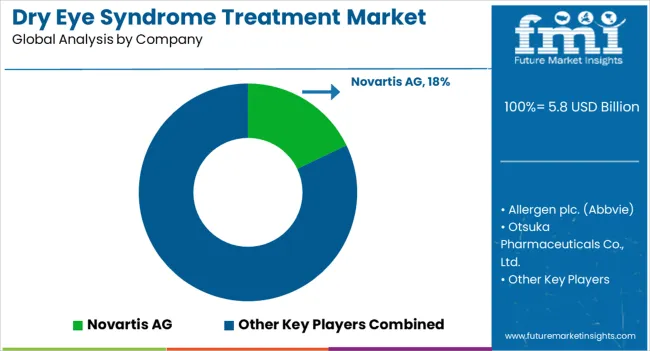
Numerous essential players heavily invest in research and development activities in the global dry eye syndrome treatment market. These players have key roles in innovating and improving products that fulfill end users' requirements.
Key players are adopting various marketing strategies to enhance global market revenue. These marketing methodologies are mergers, acquisitions, partnerships, and product launches.
Recent Development in the Dry Eye Syndrome Treatment Market
In 2024, the USA Food and Drug Administration (FDA) approved one of the dry eye products, Tyrvaya nasal spray. This spray simulates tear, oil, and mucin production, which eliminates burning sensations.
The global dry eye syndrome treatment market is estimated to be valued at USD 5.8 billion in 2025.
The market size for the dry eye syndrome treatment market is projected to reach USD 10.8 billion by 2035.
The dry eye syndrome treatment market is expected to grow at a 6.4% CAGR between 2025 and 2035.
The key product types in dry eye syndrome treatment market are artificial tears, cyclosporine, topical corticosteroids, punctal plugs, removable, dissolvable, oral omega supplements and others.
In terms of prescription, rx segment to command 58.7% share in the dry eye syndrome treatment market in 2025.






Our Research Products

The "Full Research Suite" delivers actionable market intel, deep dives on markets or technologies, so clients act faster, cut risk, and unlock growth.

The Leaderboard benchmarks and ranks top vendors, classifying them as Established Leaders, Leading Challengers, or Disruptors & Challengers.

Locates where complements amplify value and substitutes erode it, forecasting net impact by horizon

We deliver granular, decision-grade intel: market sizing, 5-year forecasts, pricing, adoption, usage, revenue, and operational KPIs—plus competitor tracking, regulation, and value chains—across 60 countries broadly.

Spot the shifts before they hit your P&L. We track inflection points, adoption curves, pricing moves, and ecosystem plays to show where demand is heading, why it is changing, and what to do next across high-growth markets and disruptive tech

Real-time reads of user behavior. We track shifting priorities, perceptions of today’s and next-gen services, and provider experience, then pace how fast tech moves from trial to adoption, blending buyer, consumer, and channel inputs with social signals (#WhySwitch, #UX).

Partner with our analyst team to build a custom report designed around your business priorities. From analysing market trends to assessing competitors or crafting bespoke datasets, we tailor insights to your needs.
Supplier Intelligence
Discovery & Profiling
Capacity & Footprint
Performance & Risk
Compliance & Governance
Commercial Readiness
Who Supplies Whom
Scorecards & Shortlists
Playbooks & Docs
Category Intelligence
Definition & Scope
Demand & Use Cases
Cost Drivers
Market Structure
Supply Chain Map
Trade & Policy
Operating Norms
Deliverables
Buyer Intelligence
Account Basics
Spend & Scope
Procurement Model
Vendor Requirements
Terms & Policies
Entry Strategy
Pain Points & Triggers
Outputs
Pricing Analysis
Benchmarks
Trends
Should-Cost
Indexation
Landed Cost
Commercial Terms
Deliverables
Brand Analysis
Positioning & Value Prop
Share & Presence
Customer Evidence
Go-to-Market
Digital & Reputation
Compliance & Trust
KPIs & Gaps
Outputs
Full Research Suite comprises of:
Market outlook & trends analysis
Interviews & case studies
Strategic recommendations
Vendor profiles & capabilities analysis
5-year forecasts
8 regions and 60+ country-level data splits
Market segment data splits
12 months of continuous data updates
DELIVERED AS:
PDF EXCEL ONLINE
Dry Scalp Treatment Market Size and Share Forecast Outlook 2025 to 2035
Global Eye Infections Treatment Market Report - Trends & Forecast 2025 to 2035
Under-Eye Treatment Market Size and Share Forecast Outlook 2025 to 2035
Donohue Syndrome Treatment Market Growth - 2025 to 2035.
Edward’s Syndrome Treatment Market – Growth & Future Prospects 2025 to 2035
Short sleep syndrome Treatment Market Growth & Demand 2025 to 2035
Adrenogenital Syndrome Treatment Market Size and Share Forecast Outlook 2025 to 2035
Aarskog-Scott Syndrome Treatment Market - Growth & Innovations 2025 to 2035
Carcinoid Syndrome Diarrhea Treatment Market
Andersen-Tawil Syndrome Treatment Market Trends - Growth & Future Prospects 2025 to 2035
Myelodysplastic Syndrome Treatment Market Size and Share Forecast Outlook 2025 to 2035
Severe Acute Respiratory Syndrome Treatment Market
Pituitary Stalk Interruption Syndrome Treatment Market - Growth & Outlook 2025 to 2035
Atypical Hemolytic Uremic Syndrome (aHUS) Treatment Market Growth and Analysis: 2025 to 2035
Eyebrow Makeup Market Size and Share Forecast Outlook 2025 to 2035
Dry-type Air-core Smoothing Reactor Market Size and Share Forecast Outlook 2025 to 2035
Eye Tracking System Market Forecast and Outlook 2025 to 2035
Dry Powder Inhaler Market Size and Share Forecast Outlook 2025 to 2035
Eye Testing Equipment Market Size and Share Forecast Outlook 2025 to 2035
Dry Vacuum Pumps Market Size and Share Forecast Outlook 2025 to 2035

Thank you!
You will receive an email from our Business Development Manager. Please be sure to check your SPAM/JUNK folder too.
Chat With
MaRIA